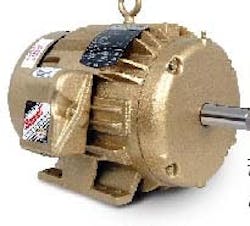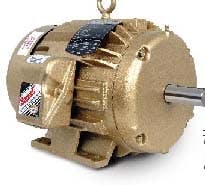Environmental concerns as well as the rising cost of energy have spurred the pharmaceutical industry to become more energy-efficient. Manufacturers are taking a hard look at ways to increase efficiency of their core equipment: motors, drives, pumps and valves.
Fortunately for manufacturers, many associations, government agencies and standards organizations have launched programs to facilitate energy efficiency improvements. Guidelines, tips and standards are in place to help companies increase efficiency, conserve natural resources and reduce emissions.
The National Electrical Manufacturers Association (NEMA) unveiled its Premium efficient electric motor program in 2001. These motors exceed the minimum energy efficiency standards required by the Energy Policy Act of 1992. In addition, NEMA Premium sets efficiency standards for an increased range of motors. NEMA Premium efficiency may be applied to general-, definite- and specialpurpose products from 1-500 hp operating on low or medium voltages. This spring, NEMA approved a standard for 50 Hz motors for premium efficiency to complement the existing 60 Hz standards.
The Consortium for Energy Efficiency (CEE), a non-profit group that includes many electric utilities among its members, recognizes NEMA Premium motors up to 200 hp as meeting their criteria for possible energy efficiency rebates. Although many motors exceed NEMA Premium efficiency ratings, motor manufacturers that are not NEMA members cannot use the NEMA Premium trademark. So, be sure to check the nameplate efficiencies to compare.
The Copper Development Association offers MotorMaster+ software, which was developed for the U.S. Dept. of Energy (DOE) by engineers at Washington State University to compare the true cost of owning motors of several efficiencies.
Improving motor efficiency is critical for pharma companies, as motors typically consume 70% of a plant’s electricity, according to Southern California Edison (SCE). SCE suggests the following measures to boost motor efficiency:
- Replace standard-efficiency motors that are greater than 1.5 hp and run more than 6,000 hours per year with energy-efficient motors.
- Adjust the sheave and speed of the impeller components of the device attached to the motor (e.g., stirrer and pump) to match the desired outflow.
- Install variable speed drives (VSDs) on pumps instead of valves.
- Install VSDs on fans previously controlled by dampers; this controls airflow more efficiently.
- Add sensors to control ventilation levels in various plant areas (such as a cleanroom).
For example, Genentech (Vacaville, Calif.) replaced the inlet vanes for the supply and return fans with VSDs on six variable volume handlers in the building. The VSDs reduce the horsepower of the fans to reduce flow; thus reducing fan motor energy use. The annual energy cost savings is about $23,000 with a reduction in peak load of approximately 40 kW.
Pumps also can consume substantial energy. The DOE’s Pump System Assessment Tool (PSAT) can help a company analyze its pumping efficiency and estimate energy and cost savings. (For more information on PSAT, visit the Best Practices Website at www1.eere. energy.gov/industry/bestpractices.) The DOE has teamed up with the Hydraulic Institute (HI; www.pumps. org) to produce “Improving Pumping System Performance: A Sourcebook for Industry.”
HI is a non-profit industry association that provides product standards and a variety of energy-related resources for pump users and specifiers, including training and guidebooks (visit www. pumplearning.org and www. pumpsystemsmatter.org).
Measures advocated by the DOE to improve pumping system efficiency include:
- Shut down unnecessary pumps. Use pressure switches to control the number of pumps in service when flow rate requirements vary.
- Restore internal clearances.
- Replace or modify oversized pumps.
- Meet variable flow rate requirements with an adjustable speed drive or multiple pump arrangement instead of throttling or bypassing excess flow.
An added motivation for companies to reduce energy usage is that many energy organizations offer incentive programs for motors and drives. Such programs support a range of measures, from simple equipment upgrades to large-scale retrofitting or new construction projects. They also may provide support for education and training.
Publicly funded energy-efficiency programs vary greatly and are administered by several different types of organizations. Generally, budget and administrative oversight are authorized by the state legislature, while regulators within each state are tasked with approving program designs and determining to what extent the organizations administering programs are reimbursed for their efforts. In 2006, approximately $2.6 billion was budgeted for these programs in the U.S. The CEE provides a summary of these programs at www.motorsmatter.org.
Below, we showcase energy-efficient motors, drives, valves and pumps that have been introduced recently.
Digital Dosing
DME series digital dosing pumps have an easy-to-use HMI that gives operators ready access to standard control features, including pulse, analog, timer, batch and anti-cavitation control. The pumps can be adjusted to 1/800 of their maximum capacity. Two new sizes provide more flexibility, from 0.02 to 39.6 GPH (75 to 150 ml/h). A brushless DC motor eliminates the need for a servo motor or a frequency converter. For handling viscous polymers or other difficult liquids, you can slow down the speed of the suction stroke to 75%, 50%, or 25% of the maximum.
Grundfos Dosing, Marietta, Ga. www.grundfos.com/dosing
Brushless Motor and Control
-Baldor
The adjustable speed Brushless Motor Control (BMC series) is easy to use and set up without programming — user trimpots and jumpers are factory-set and will work for most applications. Input command signal may be +/- 10 Vdc, a 5K speed pot, or a form “C” contact or relay for forward-stop-reverse operation. Coupled with the BMC control, the brushless motor (BSM series), provides better than 0.5% speed regulation. These packages operate directly from 115 or 230 Vac input voltage, providing accurate speed controllability for applications to 3 HP (0.18-2.2 Kw).
Baldor Electric Co., Fort Smith, Ark. www.baldor.com
Connectors for Power Aplications
M40 powerfast connectors are designed for demanding applications, handling up to 600 volts and 55 amps – enough power for a 30-hp DC motor or a 55-hp three-phase AC motor. Optionally, the cordsets can be shielded by connecting a braided shield directly to the coupling nut. This protects against electromagnetic and radio frequency interference. The line includes male or female, straight connectors, standard and custom lengths, and pigtails or extensions. Fully encapsulated mating receptacles complete the system. All connectors provide IEC IP 67 protection.
Turck, Minnetonka, Minn. www.turck.com
Sanitary Control Valves
The Model SCV-30 pneumatically actuated control valve provides a geometrically characterized plug for superior throttling dynamics. It incorporates a formed internal diaphragm that is bonded to a characterized metal plug. The diaphragm/body has smooth internal passages to facilitate cleaning and sanitizing. The plug head provides rigidity to the otherwise flexible diaphragm in the throttling zone where characterized control is desired. This valve can support fermenters, batching tanks and other sanitary equipment.
Cashco, Inc., Ellsworth, Kan. www.cashco.com
Software Reduces Drive Configuration Time
A new drive configuration feature now available in RSLogix 5000 v.16 software allows users of Allen-Bradley PowerFlex drives to consolidate drive system configuration, operation and maintenance into a single, integrated environment. Called ‘Premier Integration’, this capability helps reduce programming, installation and overall ownership costs by minimizing the number of software tools required. This feature allows users to configure both controller and drive network connections from a single location, which minimizes the potential for errors when defining the Ethernet/IP or ControlNet network I/O.
Rockwell Automation Bloomington, Minn. www.rockwellautomation.com
Positive Displacement Pumps
The FKL series high-performance positive displacement pumps are now available with stainless steel rotors to handle a wider range of pharmaceuticals. The tight clearances provide better efficiencies and gentler handling of shear-sensitive products than comparable rotary lobe pumps. The FKL is CIP-ready with no performance loss and designed for ease of maintenance. Its oil bath gearbox uses no bearing grease and requires oil change-out only every 4,000 hours.
Fristam Pumps, Middleton, Wis. www.fristam.com
High Purity Ball Valve
CleanFlow ball valves are engineered to be a true process piping component to meet the demands of the pharmaceutical industry. The “Tube-ID” port opening is dimensionally identical to the adjacent tubing to comply with ASME-BPE guidelines. Constructed of 316L grade stainless steel, the valves include weld bosses for easy purging on ends and body, and encapsulated body seals for inline weldability without disassembly.
SVF Flow Controls Santa Fe Springs, Calif. www.svf.net
Process Pump Cuts Life Cycle Costs
IC process pumps are designed in accordance with ISO 5199 and ISO 2858. The IC pump range includes 34 hydraulic sizes, flows up to 450 m3/h (1980 GPM), heads up to 160m (514 ft), temperatures from -40°C to 280°C (-40°F to 530°F) and pressures up to 25 bar (360 PSI). IC pumps offer broad hydraulic coverage while reducing the number of pump components for reduced maintenance and inventory cost. The pumps utilize an enclosed impeller for maximum efficiency, low NPSH and reduced hydraulic loads.
Goulds Pumps, Seneca Falls, N.Y. www.gouldspumps.com
Directional Control Valves
The Series TC08 and TC15 valve families of solenoid-operated, directional control valves use polymer technology to provide a lightweight, compact design for use in tight spaces. The easy-to-assemble manifold system has a reduced height because it does not require sub-bases, and quick valve changes make it maintenancefriendly. Both families feature in-line and manifoldable valves, offered with inch and metric porting options.
Bosch Rexroth Corp., Lexington, Ky. www.boschrexroth-us.com
Pinch Valves
Series A pinch valves offer positive control of fluids in sterile pharmaceutical and biotechnical applications. Red silicone and EPDM pinch tube elements comply with 21CFR Part 177.2600. The valves offer straight-through flow for enhanced draining and cleaning. A spring-loaded stem controls the closing force, enhancing pinch tube element service life. Boreline seals virtually eliminate entrapment areas. Other features include: working pressures up to 125 psig (8.6 bar), temperatures up to 285°F (140°C) and easy conversion between manual and pneumatic actuation.
Swagelok, Solon, Ohio www.swagelok.com
Automated Peristaltic Cell Culture Pump
The 313D automated cell culture pump is designed for the metering, transfer and dosing of process fluids and PBS rinse solution, aiding in the production of highquality, consistent cells. The pumphead has no valves, is self-priming, and can run dry without incurring damage. Pumped fluids remain completely contained within the tubing at all times. Designed to operate 24 hours per day, the 313D ensures overnight cell cultures are completed without the need for supervision. The pumps accept five different tube sizes for a flow range of 0.25 to 1,350 ml per minute, and pressures up to 30 psi.
Watson-Marlow Brede, Wilmington, Mass. www.watson-marlow.com
Motor Control Center Drives
The ATV61/71 series of drive controllersare in an MCC package that optimizes space. Ethernet-equipped ATV61/71 drive controllers can be configured, controlled, monitored and diagnosed over an Ethernet network with a standard web browser. Several device-level networks are also available as options. Up to six drives may be mounted in a single vertical section with no placement restrictions.
Square D/Schneider Electric, Palatine, Ill. www.squared.com
Zero Deadleg T-Valves
The GEMÜ “Zero Deadleg T-Valve” is machined from one piece of 316L barstock material. Unlike conventional designs, this valve offers the advantage of total flexibility of size ranges regarding branch
versus spool piece. Sizes range from 1/4” x 1/4” to 4” x 4”. Applications include point-of-use valves in WFI, sampling or product transfer.
GE MÜ Valves, Inc., Atlanta, Ga.www.gemu.com
High-Purity Pumps
The BioPharm Series high-purity process pumps improve process efficiencies and are easy to inspect, clean and assemble. Designed specifically for biopharma, the pumps consist of CFR 21-certified materials with complete tractability available. Features include shear sensitivity, large solids passage and validated technology.
Wilden Pump & Engineering Co. Grand Terrace, Calif. www.wildenpump.com
Constant Tempo AC Drives
V1000 series AC drives for 1/8- to 25-hp motors feature maintenance monitors to ensure each drive’s health, on-line tuning to maintain harmony with the motor,application presets to speed and simplify
installation, and RoHS compliance to ensure environmental responsibility. Yaskawa says the V1000 can reduce energy usage by as much as 72% when used for HVAC air-handling duties.
Yaskawa Electric America Waukegan, Ill. www.yaskawa.com







